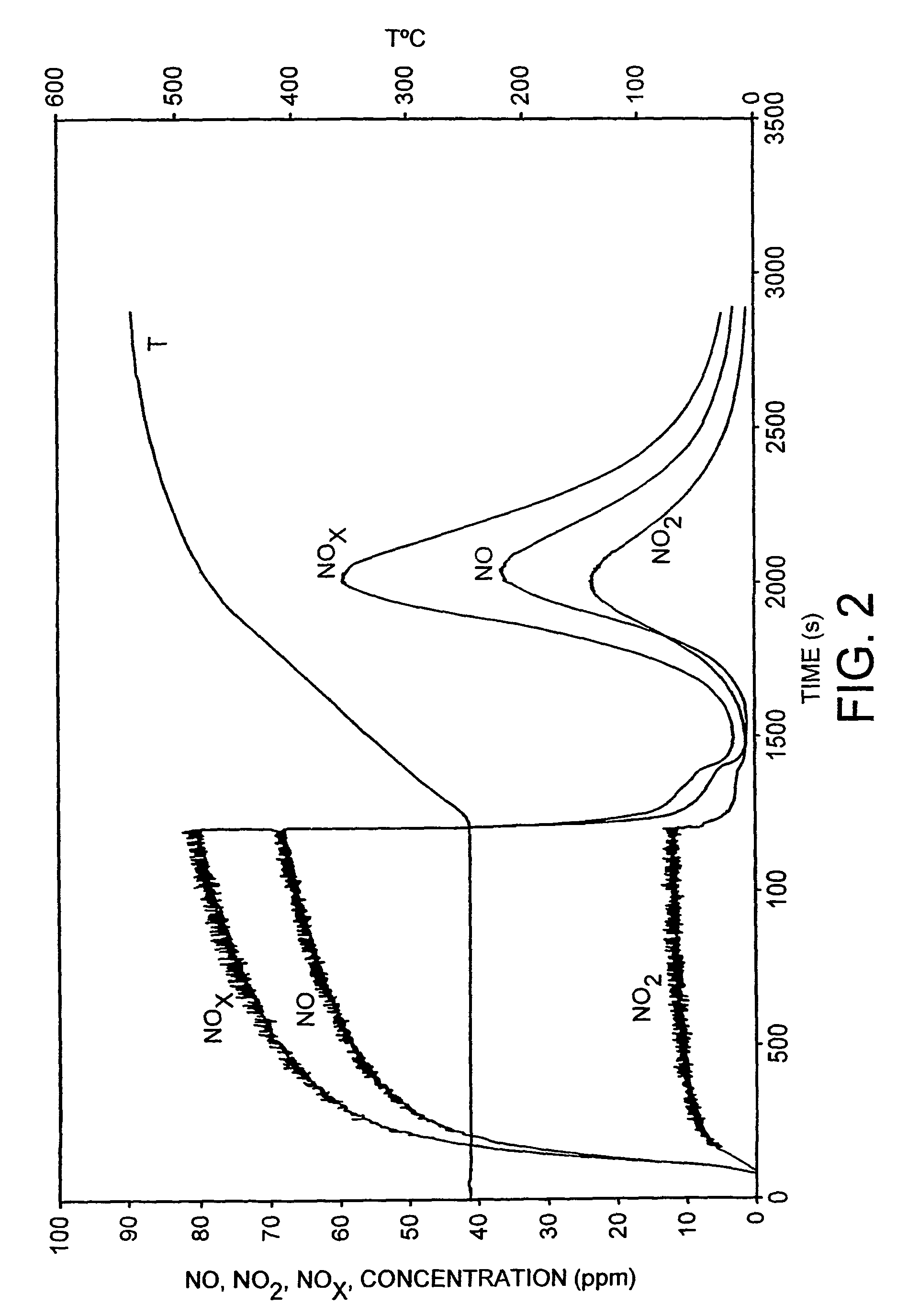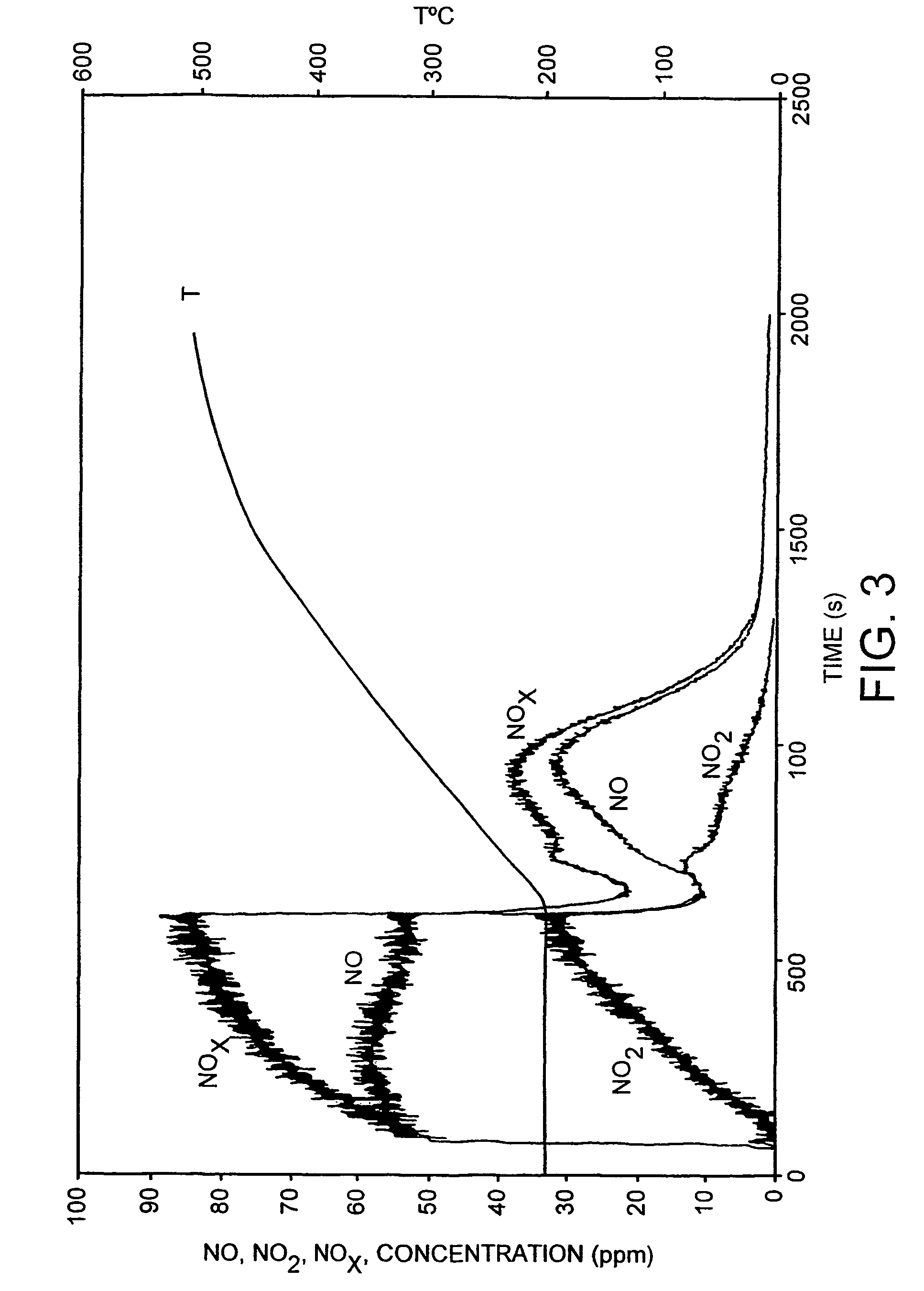Diesel exhaust system including NOx-trap
- Summary
- Abstract
- Description
- Claims
- Application Information
AI Technical Summary
Benefits of technology
Problems solved by technology
Method used
Image
Examples
example 1
[0044]A synthetic gas simulating diesel exhaust (except for containing no reductant) leaving soot filter 16 and having the following v / v composition was used:
[0045]
CO210.0%H2O10.0%O2 5.0%NO60 ppmNO230 ppmN2balance
[0046]This gas was passed at 200 or 250° C. (as described below) over NOx absorbents as follows:
[0047](a) At 250° C. for 1200 seconds over a cordierite honeycomb of 400 cpsi carrying an alumina washcoat layer and an absorbent layer of BaO with Pt 100 g / ft3 and Rh 10 g / f3 and minor proportions of alumina, ceria and ZrO2. The results are shown in FIG. 2;
[0048](b) At 200° C. for 600 seconds over a cordierite honeycomb having 400 cpsi, carrying an alumina washcoat and 400 g / ft3, calculated as Cu, of CuO. The results are shown in FIG. 3;
[0049](c) At 200° C. for 600 seconds over a cordierite honeycomb having 400 cpsi, carrying an alumina washcoat, 400 g / ft3, calculated as Cu, of CuO and 100 g / f3 of Pd, calculated as metal. The results are shown in FIG. 4.
[0050]For each the outlet...
example 2
[0061]The exhaust gas from a production VOLVO 12-litre diesel engine was fed to a ceramic honeycomb-supported platinum / alumina oxidation catalyst, in which its content of NO was about 90% oxidised to NO2. The resulting gas was fed to a NOx absorber as used in the run reported in Example 1. The results are shown graphically in FIG. 2. The engine was operated in idling and high-speed conditions, alternating at 850 second intervals. Representative values of temperature, composition v / v and flow rate of the gas leaving the absorber in idling and high-speed conditions, as obtained reproducibly over many cycles, are set out in Table 2.
[0062]
TABLE 2IdleHigh Speed(absorbing)(regenerating)Temp ° C.150380NO2, ppm10260NO, ppm180455O2, %1910.9CO, %0.40.8CO2, %1.387.14HC, ppm195.7Total flow kg / h259560NO2, g / h2.59145.60NO, g / h46.62254.80NO2 / NOx %5.335.6
[0063]It is evident that the rate of emission of NO2 in idling is low and may cause little if any offence. At the higher temperature the gas conta...
PUM
| Property | Measurement | Unit |
|---|---|---|
| Temperature | aaaaa | aaaaa |
| Temperature | aaaaa | aaaaa |
| Temperature | aaaaa | aaaaa |
Abstract
Description
Claims
Application Information
 Login to View More
Login to View More - R&D
- Intellectual Property
- Life Sciences
- Materials
- Tech Scout
- Unparalleled Data Quality
- Higher Quality Content
- 60% Fewer Hallucinations
Browse by: Latest US Patents, China's latest patents, Technical Efficacy Thesaurus, Application Domain, Technology Topic, Popular Technical Reports.
© 2025 PatSnap. All rights reserved.Legal|Privacy policy|Modern Slavery Act Transparency Statement|Sitemap|About US| Contact US: help@patsnap.com



